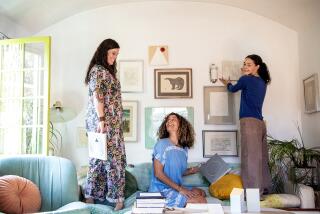HOME DESIGN : Lighting, Windows Expand Interiors
- Share via
As Orange County’s population gets bigger, living spaces are getting smaller, posing decorating dilemmas for owners of homes and condominiums.
Patricia Mickey of PMA Design Group in Costa Mesa and Jason Titus of Jason Titus Interiors in Fullerton believe that such problems can be solved, creating rooms that are eye-catching--and appear larger.
Mickey says the key to visually increasing the size of a room is to keep an eye on continuity. “The more continuity you have in your backgrounds--floor, walls, ceiling--the more spacious the room will appear. For example, on a theater stage, they achieve the illusion of limitless space through use of a backdrop that makes the stage look as though it goes on forever, thereby dissolving room boundaries. You can utilize similar techniques to create the same kind of effect in a small room.”
The two designers say that the direction of natural lighting and its source are paramount to making a room appear more spacious.
“How the light comes in, where it comes from and, most importantly, what it reflects upon, are all things to be considered,” says Titus. Both point out that a room with a southern exposure may look smaller because of the glare from the sun.
“Unless natural lighting is increased, a room will still appear small, regardless of what color it is painted,” says Titus. However, he says that too much light can also contribute to a boxed-in feeling.
The most important factor with natural lighting is where the light ais being directed. Mickey advises: “Direct your focus to what you want people to see. Clean lines and smooth transitions aid in establishing continuity.”
When remodeling a house or condo, Titus says, windows should be viewed with a critical eye. Whenever possible, high, narrow windows--like those often found in homes built during the ‘40s, ‘50s and ‘60s--should be replaced by sliding glass or French doors, he says. “With this effective treatment, the eye is not trapped at the base of the wall--the eye travels through the glass or door.” To give the illusion of even more spaciousness, he suggests building or utilizing an outside patio or deck, thus creating the feeling that the outside and inside are one.
The use of window treatments such as wall-to-wall draperies or ruffled curtains is discouraged. “Less is definitely more ,” says Mickey.
Titus recommends bare windows whenever possible, or mini-blinds. “Wall-to-wall draperies shrink a small room even more,” he says.
The designers recommend use of mirrors but warn against incorrect placement. “You have to think about what you are mirroring,” says Titus. “If you mirror a dining room wall and it reflects the neighbor’s car up on blocks or your garbage cans outside, you are going to be pretty upset!”
Mickey tells clients to “remember what it is you want to look at and what you want your guests to see. If you mirror a wall that reflects another blank wall you have accomplished nothing.” Both designers suggest the use of framed mirrors, which they say look beautiful and create light.
They warn against the use of area rugs in a small space, explaining that in a small room the eye is drawn to the dimensions of the area rug, rather than to the overall dimensions of the room itself. “And when using wood or tile, it is best to run the lines on a diagonal--this way the eye will assess the size of the room based on the diagonal line, not on the square shape of the room,” Titus advises.
As for furnishings, Mickey urges people not to dismiss large-scale furniture as too big for small rooms. “One large-scale piece may work better than a lot of clutter and several smaller pieces. In a living room, for example, you may have a stereo, TV, desk and a crystal collection. Combine all this into a single built-in wall unit, incorporate mirror and lighting, and you have utilized all the options to make that room look as comfortable and spacious as possible.
“A small room can either be cozy or cluttered--cramped or intimate. With some thought and planning you can achieve the look you want.”
More to Read
Sign up for Essential California
The most important California stories and recommendations in your inbox every morning.
You may occasionally receive promotional content from the Los Angeles Times.






